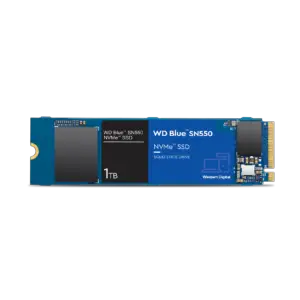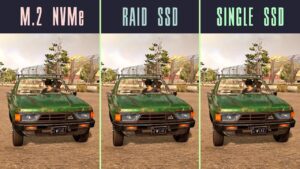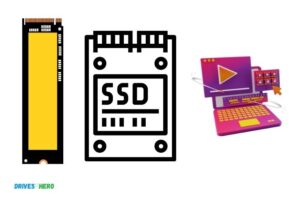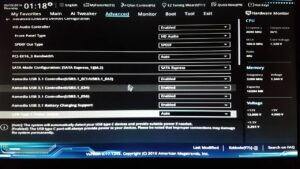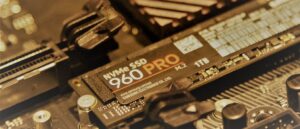Nvme Vs Sata Ssd Power Consumption: Which One Is Better?
NVMe SSDs typically consume more power than SATA SSDs. While both types of drives consume relatively small amounts of power, NVMe SSDs are faster and more efficient, resulting in slightly higher power consumption.
NVMe (Non-Volatile Memory Express) SSDs are a type of solid-state drive that connect via the PCIe (Peripheral Component Interconnect Express) interface, which allows for faster data transfer speeds.
SATA (Serial Advanced Technology Attachment) SSDs, on the other hand, use the SATA interface, which is slower than PCIe. Because NVMe SSDs are faster and more efficient, they tend to consume more power than SATA SSDs.
While NVMe SSDs do consume more power than SATA SSDs, it’s important to remember that both types of drives are much more energy-efficient than traditional hard drives.
Given the faster speeds and higher performance of NVMe drives, the increased power consumption can often be worth it, especially in high-performance computing environments.

Key Takeaway
6 Features Of Nvme Vs Sata Ssd Power Consumption
| Feature | NVMe SSD | SATA SSD |
|---|---|---|
| Interface | PCIe | SATA |
| Maximum Throughput | Up to 3500 MB/s | Up to 600 MB/s |
| Average Power Consumption | 6-7W (active), <2W (idle) | 4-5W (active), <1W (idle) |
| Peak Power Consumption | Up to 8-10W | Up to 5-6W |
| Energy Efficiency | Higher throughput per watt | Lower power in idle state |
| Ideal Usage | High-end gaming, data centers, intense workloads | Consumer-level computing, budget systems |
Five Facts About Nvme Vs Sata Ssd Power Consumption
Understanding Power Consumption In Ssds
Understanding power consumption in SSDs is crucial, especially when comparing NVMe and SATA SSDs.
Considering the power efficiency of each type can help you make an informed decision based on your specific needs and preferences.
Overview Of Power Consumption In Solid-State Drives (Ssds)
Solid-state drives (SSDs) have revolutionized storage technology, offering faster performance and greater efficiency compared to traditional hard disk drives (HDDs).
One crucial aspect of SSDs is their power consumption. Understanding the power consumption in SSDs is vital, as it can impact device battery life, heat generation, and overall system efficiency.
Factors Influencing Power Consumption In Ssds
Power consumption in SSDs is influenced by several factors that synergistically contribute to the overall performance and efficiency of the drive.
These factors include:
NAND flash technology: The type and generation of NAND flash memory used in an SSD can significantly impact its power consumption. Newer NAND technologies, such as 3D NAND, tend to offer improved power efficiency compared to older planar NAND.
Controller efficiency: The SSD controller plays a crucial role in managing data transfers, wear leveling, error correction, and power distribution within the drive. An efficient controller design can minimize power consumption by optimizing data access and reducing unnecessary operations.
Firmware optimizations: SSD firmware includes various algorithms and optimizations that enhance its performance and power efficiency. Advanced firmware can intelligently manage power states, idle times, and background tasks, resulting in reduced power consumption during low activity periods.
Power management features: SSDs often feature built-in power management features that allow them to adjust power consumption based on usage patterns and system requirements.
These features include low power states like Device Sleep (DevSleep) and Advanced Power Management (APM), which enable the drive to conserve power during periods of inactivity.
Workload characteristics: The nature of the workload and the type of data being accessed can also impact power consumption in SSDs. Different data access patterns, such as sequential or random reads/writes, can vary in their power requirements.
Power consumption in SSDs is influenced by various factors, including NAND flash technology, controller efficiency, firmware optimizations, power management features, and workload characteristics.
By understanding these factors, users can make informed choices when selecting SSDs that offer optimal power efficiency without compromising performance.
Exploring Nvme Ssd Power Consumption
Explore the power consumption of Nvme and SATA SSDs, comparing their efficiency and energy usage. Discover the differences in power consumption between these two solid-state drive technologies.
Nvme (Non-Volatile Memory Express) SSDs have gained remarkable popularity for their exceptional speed and performance.
Advantages Of Nvme Ssds Over Traditional Sata Ssds:
- Faster data transfer speeds: Nvme SSDs utilize the PCIe bus interface, enabling them to achieve significantly higher transfer rates compared to SATA SSDs. This translates into quicker access times and reduced overall power consumption.
- Enhanced parallelism: Nvme SSDs employ multiple input/output (I/O) queues and support concurrent operations, allowing for efficient queuing and processing of data. As a result, these SSDs consume less power during data-intensive tasks.
Examining Power Efficiency In Nvme Ssds:
- Low latency and reduced idle power consumption: Thanks to their direct connection to the CPU, Nvme SSDs exhibit lower latency, which leads to reduced power consumption during idle states. This advantage makes them ideal for scenarios where power optimization is crucial.
- Power-saving features and technologies: Nvme SSDs often come equipped with advanced power-saving features, such as L1.2 idle power mode and DevSleep. L1.2 idle power mode allows the drive to enter an ultra-low power state when not in use.
Impact On Battery Life In Laptops And Portable Devices:
Extended battery life:
- The power efficiency of Nvme SSDs can have a significant impact on the battery life of laptops and portable devices.
- With reduced power consumption during active use and idle states, Nvme SSDs help extend the battery runtime, enabling users to work or play for longer periods without worrying about running out of power.
Nvme SSDs stand out not only for their exceptional performance but also for their power efficiency. With low latency, reduced idle power consumption, and power-saving features, Nvme SSDs provide a compelling advantage over traditional SATA SSDs.
The positive impact on battery life makes them an excellent choice for users seeking both speed and power optimization in their devices.
Analyzing Sata Ssd Power Consumption
Analyzing the power consumption of Nvme and SATA SSDs reveals interesting insights. By comparing their power usage, we can assess efficiency and make informed decisions regarding storage options.
Overview Of Sata (Serial Advanced Technology Attachment) Ssds:
SATA (Serial Advanced Technology Attachment) SSDs are a popular choice for storage in various devices due to their affordability and compatibility.
Here are the key points to understand about SATA SSDs:
- SATA is a standard interface that connects storage devices to a computer’s motherboard.
- SATA SSDs use NAND flash memory to store and retrieve data quickly.
- These drives are available in various capacities, allowing users to choose the one that suits their storage needs.
- SATA SSDs are commonly found in laptops, desktops, and gaming consoles, offering faster data transfer speeds compared to traditional hard drives (HDDs).
- While SATA SSDs provide speed improvements over HDDs, they are outperformed by NVMe (Non-Volatile Memory Express) SSDs in terms of performance.
Key Differences Between Nvme And Sata Ssds:
When comparing NVMe and SATA SSDs, it’s important to note the following differences:
- NVMe SSDs use a different interface, specifically designed for solid-state storage, which is faster than the SATA interface used by traditional SSDs.
- NVMe SSDs connect to the motherboard through PCIe (Peripheral Component Interconnect Express) slots, allowing for faster data transfer speeds and lower latency.
- SATA SSDs, on the other hand, use the older SATA interface and are limited by its speed capabilities.
- NVMe SSDs are known for their superior performance, making them ideal for demanding tasks such as gaming, content creation, and data-intensive applications.
- While NVMe SSDs generally offer higher performance, SATA SSDs are still an excellent choice for everyday computing needs.
Power Consumption Characteristics Of Sata Ssds:
Understanding the power consumption characteristics of SATA SSDs can help users make informed decisions when choosing storage options.
Here are the key points to consider:
- SATA SSDs consume relatively low power compared to traditional HDDs.
- These drives have idle power consumption levels, which indicate the amount of power they consume when not actively reading or writing data.
- SATA SSDs typically consume less power during idle periods compared to their NVMe counterparts.
- Idle power consumption can have an impact on overall system power usage, as devices with lower power consumption can lead to longer battery life in laptops and reduced power usage in desktops.
- When it comes to read and write operations, SATA SSDs may consume slightly more power compared to NVMe SSDs, although the difference in power consumption is generally minimal.
- SATA SSDs are still energy-efficient overall, providing a balance between performance and power consumption.
SATA SSDs offer a cost-effective and energy-efficient storage solution for various devices.
While they may not provide the same level of performance as NVMe SSDs, they are still a reliable choice for everyday tasks and can significantly enhance the speed and responsiveness of systems when compared to traditional HDDs.
Comparing Power Efficiency Between Nvme And Sata Ssds
Discover the power efficiency battle between NVMe and SATA SSDs. Find out which one takes the lead in power consumption. When it comes to choosing between Nvme and SATA SSDs, power consumption is a crucial factor to consider.
Performance-To-Power Ratio In Nvme Ssds:
Nvme SSDs excel in terms of power efficiency, offering an impressive performance-to-power ratio.
Here’s why:
- Nvme SSDs are designed to communicate directly with the CPU via PCIe lanes, minimizing latency and boosting overall performance.
- These SSDs consume less power during data transfer, resulting in higher performance levels while keeping power consumption in check.
- Due to their efficient architecture, Nvme SSDs deliver exceptional read and write speeds without compromising power efficiency.
Power Consumption Benchmarks And Measurements:
To evaluate the power consumption of Nvme and SATA SSDs accurately, several benchmark tests and measurements have been conducted.
Key findings include:
- Nvme SSDs generally consume less power compared to SATA SSDs in both idle and active states.
- In idle mode, Nvme SSDs utilize significantly less power, allowing for reduced energy consumption and increased battery life in laptops and other portable devices.
- During intensive tasks, Nvme SSDs still maintain lower power consumption levels, ensuring optimal performance without draining excessive power from the system.
Real-World Scenarios For Power Consumption Comparisons:
To understand the power consumption differences between Nvme and SATA SSDs in real-world scenarios, consider the following:
- When running resource-intensive applications or operating multiple applications simultaneously, Nvme SSDs prove to be more power-efficient, delivering smoother performance while consuming less energy.
- In scenarios where power constraints are a concern, such as in data centers or mobile devices, the power efficiency of Nvme SSDs provides a significant advantage over SATA SSDs, leading to reduced energy costs and extended battery life.
Power Efficiency Gains With Nvme Ssds:
Opting for Nvme SSDs over SATA SSDs brings notable power efficiency gains.
Here are the key benefits:
- With the efficient utilization of PCIe technology, Nvme SSDs minimize power consumption without sacrificing performance, making them an ideal choice for power-conscious users.
- Lower power consumption in Nvme SSDs translates into reduced heat generation, resulting in cooler operating temperatures and enhanced system stability.
- The power efficiency gains of Nvme SSDs contribute to a greener environment by reducing carbon footprint and energy consumption.
Considerations For Choosing Between Nvme And Sata Ssds Based On Power Consumption:
When deciding between Nvme and SATA SSDs, power consumption is a crucial consideration.
Here are a few points to help you make an informed decision:
- If power efficiency is a significant factor for your use case, Nvme SSDs offer superior power savings and performance advantages, especially in resource-intensive applications.
- In scenarios where power constraints or extended battery life are top priorities, Nvme SSDs provide a clear advantage over SATA SSDs, thanks to their lower power consumption.
- However, if power consumption is less of a concern and budget is a significant factor, SATA SSDs can still deliver reliable performance, albeit at a slightly higher power consumption level.
Nvme SSDs exhibit impressive power efficiency gains, offering a higher performance-to-power ratio compared to SATA SSDs.
Understanding the power consumption benchmarks, real-world scenarios, and considerations outlined above can help you make an informed decision when choosing between Nvme and SATA SSDs based on power consumption requirements.
FAQ On Nvme Vs Sata Ssd Power Consumption
How does NVMe SSD power consumption compare to SATA SSD power consumption?
NVMe SSDs typically consume less power than SATA SSDs due to their more efficient design. NVMe SSDs use fewer components and incorporate advanced power-saving features, resulting in lower power consumption than SATA SSDs.
Does NVMe SSDs consume more power than HDD drives?
Yes, NVMe SSDs typically consume more power than HDD drives, due to their faster speeds and more advanced components.
Is it possible to reduce power consumption on NVMe SSDs?
Yes, it is possible to reduce power consumption on NVMe SSDs by using features like DevSleep and SLFM (Selective Power Management).
These features allow the SSD to reduce its power state to conserve power and improve battery life in various situations.
What are the benefits of using NVMe SSDs?
NVMe SSDs offer several benefits, such as faster read/write speeds, improved security, better memory latency, and lower power consumption than SATA SSDs.
Does the type of NVMe SSD have any effect on power consumption?
Yes, the type of NVMe SSD drive (e.g. M.2, mSATA, PCIe) does have an effect on power consumption. Some types of NVMe SSDs, such as PCIe-based drives, are more power-efficient than other types.
Conclusion
When comparing NVMe and SATA SSDs in terms of power consumption, it is evident that NVMe SSDs have a clear advantage.
Their efficient design and use of the PCIe interface allow for faster data transfer rates while consuming less power. This is particularly crucial for energy-conscious individuals and organizations looking to reduce their carbon footprint.
NVMe SSDs also offer increased storage capacity options, making them a practical choice for those in need of larger storage spaces.
With the rapid advancements in technology, NVMe SSDs are becoming more affordable and widely available, making them a viable choice for consumers and businesses alike.

